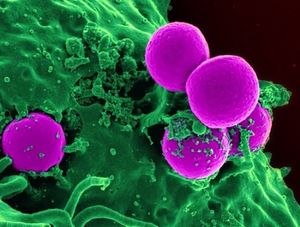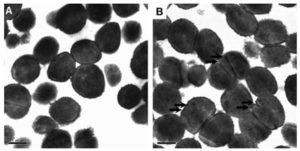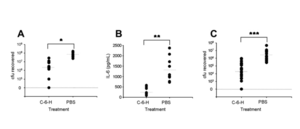Free Fatty Acids as antibacterial agents against several super pathogens including MRSA: Difference between revisions
Mccannsmithe (talk | contribs) |
Mccannsmithe (talk | contribs) |
||
| Line 1: | Line 1: | ||
{{Curated}} | {{Curated}} | ||
==Introduction== | ==Introduction== | ||
[[Image:MRSA2.jpg|thumb|300px| | [[Image:MRSA2.jpg|thumb|300px|left| Scanning electron micrograph of Methicillin-resistant Staphylococcus aureus (MRSA), USA300 strain, being engulfed by a human neutrophil. From [https://commons.wikimedia.org/wiki/File%3AHuman_neutrophil_ingesting_MRSA.jpg NIH].]] | ||
<br>At right is a sample image insertion. It works for any image uploaded anywhere to MicrobeWiki. The insertion code consists of: | <br>At right is a sample image insertion. It works for any image uploaded anywhere to MicrobeWiki. The insertion code consists of: | ||
Revision as of 15:38, 16 November 2015
Introduction

At right is a sample image insertion. It works for any image uploaded anywhere to MicrobeWiki. The insertion code consists of:
Double brackets: [[
Filename: Ebola_virus2.jpg
Thumbnail status: |thumb|
Pixel size: |300px|
Placement on page: |left|
Legend/credit: Electron micrograph of the Ebola Zaire virus. This was the first photo ever taken of the virus, on 10/13/1976. By Dr. F.A. Murphy, now at U.C. Davis, then at the CDC.
Closed double brackets: ]]
Other examples:
Bold
Italic
Subscript: H2O
Superscript: Fe3+
Introduce the topic of your paper. State your health service question, and explain the biomedical issues.
About Free Fatty Acids
Include some current research, with at least one figure showing data.

History of Fatty Acids as Antimicrobial Agents
Include some current research, with at least one figure showing data.

Bactericidal Effects of Fatty Acids on Methicillin Resistant and Susceptible Staphylococcus aureus
Include some current research, with at least one figure showing data.

Conclusion
References
[1] Wikimedia. NIH.
Authored for BIOL 291.00 Health Service and Biomedical Analysis, taught by Joan Slonczewski, 2016, Kenyon College.
